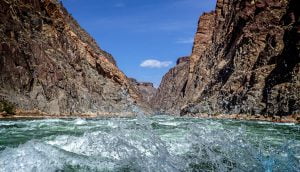February 7, 2024
What do atmospheric rivers mean for the Colorado River Basin?
Outside, at our office in Salt Lake City, the sky is dark and the rain is falling. Overall the winter in Utah has felt mild. January was full of warmer than average temperatures due to a high pressure over the Western United States. Lately things have been changing. California has been pummeled with moisture from an atmospheric river from the Pacific Ocean. Los Angeles has received 75% of its annual rain total in only the second month of the year. Mammoth Mountain ski resort is reporting 46″ of snow from its latest storm, and there is still more to come.
California “wrings” out most of the water from these atmospheric rivers; but Utah, Wyoming, and Colorado also receive moisture as rain and snow in the high country. This is a good thing for the drought stricken Colorado River Basin, and for our river company. We have been in a prolonged drought for well over 20 years at this point. Glen Canyon Dam reached its lowest point since filling on April 11, 2023 with an elevation of 3519.7′. Thanks to a good snowpack last year the river climbed to a recent high on July 10, 2023 of 3584.4′. The reservoir has slowly dropped since that point and sits at 3563.8′ today(February 7, 2024). Lake Powell is currently 33% of full storage. Lake Mead has followed a similar trajectory and currently sits at 1074′ which is just under 37% of full capacity.
The Colorado River basin’s two main rivers are the Green and Colorado River. The Green River starts in the Wind River Mountains in Wyoming. The Colorado River starts in the Rocky Mountains of Colorado. The two great rivers join in Canyonlands National Park near Moab, Utah. From there, the combined river, continues its journey through Cataract Canyon, Glen Canyon, and into Lake Powell. The Grand Canyon starts at Lees Ferry which is 15 miles below Glen Canyon Dam.
Colorado River Basin Snowpack-February 7, 2024
As of today, the snowpack in the Colorado River basin is hovering right around 100%. This likely will increase over the next week.

This data is promising for our 2024 river season. Average snowpack means good water on the Green and Colorado Rivers all season. During an average water year Cataract Canyon usually peaks somewhere around 50,000 cfs. The Green River in Desolation Canyon peaks somewhere around 25,000 cfs and the Colorado River in Westwater Canyon usually peaks around 28,000 cfs.
The Colorado River in Grand Canyon is controlled by Glen Canyon Dam. July and August tend to have the highest flows in Grand Canyon because of the increased demand for power to run air conditioning across the southwest.
Tatsheshini and Alsek River Water Supply Updates
In Alaska where we run the Tatshenshini and Alsek Rivers the snowpack is 116% of average.
We are really excited to get back on the river. No one knows what the future of the Colorado River will be, but at least for this year it looks good! Don’t miss your chance to go rafting in 2024. For a complete list of the trips we offer visit: www.crateinc.com.





